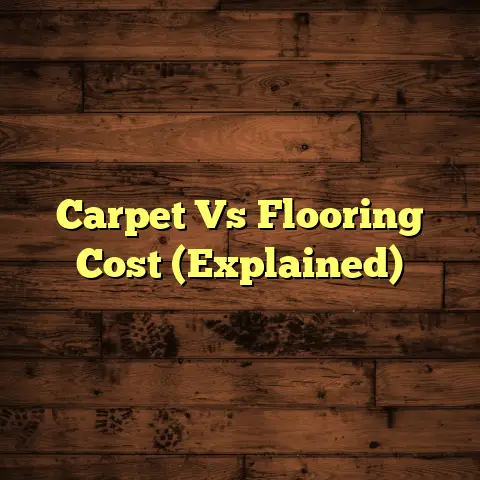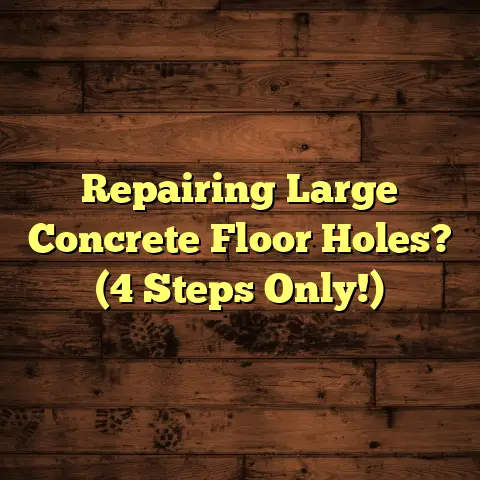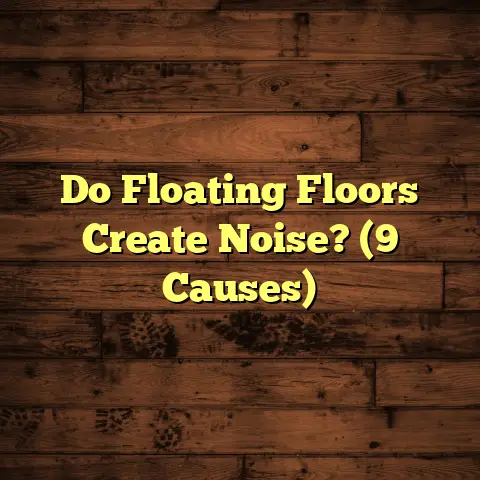Bugs Eating Your Wood Floors? (1 Urgent Fix!)
Isn’t it amazing how beautifully crafted wood floors can completely transform a house into a home?
I’ve seen it countless times in my years as a flooring contractor.
From the rich, dark tones of exotic woods to the rustic charm of reclaimed materials, wood flooring adds a touch of elegance and warmth that’s hard to beat.
We invest a lot in these floors, right?
Choosing the perfect type, the installation… it’s a big deal.
But what if I told you there’s a silent threat lurking beneath the surface, ready to undermine that investment? I’m talking about bugs.
Yep, those pesky little critters can turn your dream floors into a nightmare if you’re not careful.
Did you know that, according to the National Pest Management Association (NPMA), termites alone cause over $5 billion in property damage annually in the US?
And that’s just termites!
Other wood-destroying insects can wreak havoc too. That’s why it’s crucial to act fast.
Let’s dive in and figure out how to protect your beautiful wood floors!
Section 1: Understanding
Wood-Destroying Insects
Okay, so who are the usual suspects when it comes to munching on your precious wood floors? Let’s break it down.
1. The Common Culprits:
-
Termites: These guys are probably the most well-known wood-destroying insects. They live in colonies and feed on cellulose, which is found in wood. There are different types of termites, like subterranean, drywood, and dampwood termites, each with their own preferences and behaviors.
- Life Cycle: Termites have a complex life cycle, starting from eggs, then nymphs, and finally adults. The adults can be workers, soldiers, or reproductives (kings and queens).
- Behavior: Subterranean termites build mud tubes to travel from the soil to the wood, while drywood termites live entirely within the wood they infest.
- Damage: Termite damage often appears as hollowed-out wood with mud or soil filling the galleries.
-
Carpenter Ants: Unlike termites, carpenter ants don’t actually eat the wood. Instead, they excavate it to create nests. They prefer damp or decayed wood, but they can also infest sound wood.
- Life Cycle: Carpenter ants also have a complex life cycle, similar to termites, with eggs, larvae, pupae, and adults.
- Behavior: They are nocturnal and create smooth, clean tunnels in the wood. You might see piles of sawdust-like material (frass) near their entry points.
- Damage: Carpenter ant damage weakens the wood structure and can lead to costly repairs.
-
Wood-Boring Beetles: These beetles, like powderpost beetles and deathwatch beetles, lay their eggs in the wood. The larvae then bore through the wood, feeding on it as they grow.
- Life Cycle: Wood-boring beetles have a complete metamorphosis, with egg, larva, pupa, and adult stages.
- Behavior: The larvae are the ones that cause the most damage. They create tiny tunnels in the wood, leaving behind a fine, powdery dust.
- Damage: Beetle infestations can weaken the wood and make it unsightly, with numerous small holes on the surface.
2. Signs of Infestation:
Alright, now that we know who the culprits are, how do you actually tell if they’re crashing at your place? Here are some telltale signs:
-
Small Holes: Keep an eye out for small, round, or oval holes on the surface of your wood floors. These could be entry or exit holes made by wood-boring beetles.
-
Sawdust Piles: Finding small piles of sawdust near your baseboards, walls, or furniture? That’s a big red flag. It could be frass from carpenter ants or powderpost beetles.
-
Mud Tubes: Subterranean termites build mud tubes to travel from the soil to the wood. Look for these tubes along your foundation walls, in crawl spaces, or near your wood floors.
-
Unusual Sounds: Sometimes, you can actually hear the pests munching away! Listen for faint clicking or tapping sounds coming from your floors, especially at night.
-
Weak or Damaged Wood: If you notice that your wood floors are starting to feel soft, spongy, or easily damaged, it could be a sign of internal infestation.
-
Visible Insects: Of course, the most obvious sign is actually seeing the insects themselves. Termites, carpenter ants, or beetles crawling around your home are a clear indication of a problem.
Section 2: The Urgent Fix –
A Step-by-Step Guide
Okay, so you suspect you have a bug problem. Don’t panic! Here’s what you need to do ASAP.
1. Identifying the Type of Pest:
First things first, you need to figure out who your uninvited guests are.
Why? Because different pests require different treatment methods.
-
Visual Inspection: Grab a flashlight and get down on your hands and knees. Carefully examine the affected areas and try to identify the insects.
-
Check for Specific Signs: Look for the telltale signs mentioned earlier, like mud tubes (termites), sawdust piles (carpenter ants or beetles), or small holes (beetles).
-
Professional Assistance: If you’re not sure what you’re dealing with, don’t hesitate to call a pest control professional. They can accurately identify the pest and recommend the best course of action.
2. Immediate Actions:
Alright, once you’ve identified the culprit, it’s time to take action. Here’s the urgent fix I recommend:
-
Clear the Area: Remove any furniture, rugs, or other items from the affected area. This will give you better access to the infested wood and prevent the pests from spreading.
-
Vacuum Thoroughly: Use a vacuum cleaner with a hose attachment to remove any visible insects, sawdust, or debris from the area.
-
Apply Borate Treatment: Borate is a natural mineral salt that’s toxic to wood-destroying insects but relatively safe for humans and pets. You can find borate-based products at most home improvement stores.
- How to Apply: Follow the instructions on the product label. Generally, you’ll need to mix the borate powder with water and apply it to the affected wood using a brush, sprayer, or injector. Make sure to saturate the wood thoroughly.
-
Seal Entry Points: Identify any cracks, gaps, or holes in your foundation, walls, or around pipes that could be serving as entry points for the pests. Seal these openings with caulk, sealant, or steel wool.
3. Temporary Repairs:
While you’re waiting for a professional extermination or full restoration, you can take some temporary steps to fix visible damage:
-
Wood Filler: For small holes and cracks, use a wood filler that matches the color of your flooring. Apply the filler to the damaged area, let it dry, and then sand it smooth.
-
Patching Materials: For larger areas of damage, you may need to use a patching material like epoxy or wood patch. Follow the instructions on the product label to apply the patch and blend it with the surrounding wood.
Section 3: Long-Term
Prevention Strategies
Okay, you’ve tackled the immediate problem. Now, how do you make sure those pesky bugs don’t come back? Here are some long-term prevention strategies I swear by:
1. Regular Maintenance:
-
Regular Inspections: Make it a habit to inspect your wood floors regularly for any signs of pests, moisture damage, or other problems. Pay special attention to areas near baseboards, walls, and plumbing fixtures.
-
Moisture Control: Wood-destroying insects love moisture, so it’s important to keep your wood floors dry. Repair any leaks promptly, use a dehumidifier in damp areas, and ensure proper ventilation.
-
Proper Cleaning: Avoid using excessive water when cleaning your wood floors. Use a damp mop or cloth and a pH-neutral wood floor cleaner. Never use harsh chemicals or abrasive cleaners, as they can damage the wood and make it more susceptible to pests.
2. Investing in Treatments:
-
Borate Treatments: Consider applying a borate treatment to your wood floors as a preventive measure. Borate can penetrate the wood and make it resistant to wood-destroying insects.
-
Protective Coatings: Apply a protective coating, like polyurethane or varnish, to your wood floors. This will create a barrier that can help prevent pests from entering the wood.
3. Professional Inspections:
- Annual Inspections: Schedule regular inspections with a pest control professional, especially if you live in an area with a high risk of pest infestations. They can identify potential problems early on and recommend appropriate treatment options.
Section 4: When to Call the
Professionals
Okay, so you’ve done your best to tackle the problem yourself, but sometimes, you just need to call in the big guns. Here are some scenarios where I definitely recommend seeking professional help:
-
Severe Infestation: If the infestation is widespread or causing significant damage, it’s time to call a pest control professional. They have the expertise and equipment to effectively eradicate the pests and prevent further damage.
-
Unsure of Pest Identification: If you’re not sure what type of pest you’re dealing with, it’s best to call a professional. They can accurately identify the pest and recommend the appropriate treatment.
-
DIY Treatments Fail: If you’ve tried DIY treatments and they’re not working, it’s time to call a professional. They may need to use more powerful treatments or implement a more comprehensive pest control plan.
-
Structural Damage: If the pest infestation has caused structural damage to your home, you’ll need to call a professional contractor to repair the damage. They can assess the extent of the damage and recommend the appropriate repairs.
Potential Costs:
Professional extermination costs can vary widely depending on the type of pest, the severity of the infestation, and the size of your home. According to HomeAdvisor, the average cost of termite treatment is between $500 and $2,500. Carpenter ant treatment can range from $200 to $1,000, while wood-boring beetle treatment can cost between $300 and $800.
Restoration costs will depend on the extent of the damage. Minor repairs, like filling holes and cracks, may only cost a few hundred dollars. However, major repairs, like replacing entire sections of flooring, can cost thousands of dollars.
Conclusion:
Wood flooring is a beautiful and valuable asset to any home. While pests can pose a significant threat, understanding how to identify and treat infestations can protect your investment.
Remember that one urgent fix I mentioned: Apply a borate treatment to any affected areas. This can help kill the pests and prevent them from spreading.
Don’t wait until it’s too late! Take immediate action if you suspect an issue and safeguard your beautiful wood floors for years to come.
You got this!





